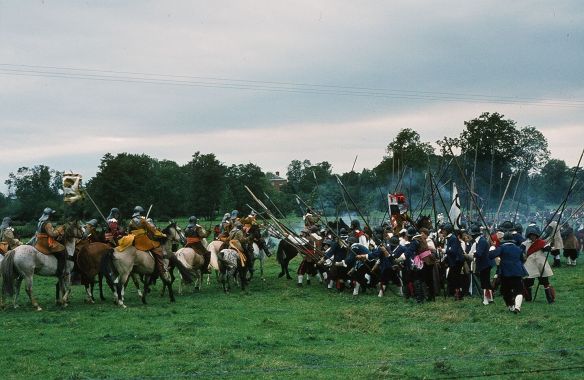Marston Moor was, as Cromwell exalted, `an absolute victory obtained by the Lord’s blessing’. Fifteen hundred allied soldiers had perished, as had three thousand-perhaps as many as four thousand-of the king’s men. Except for the Whitecoats, the majority of those who died were hacked to pieces as they broke and tried to escape from the field.
But the king made up for his loss in the north with a victory in the south-west.
On 29 March 1644 General Sir William Waller’s parliamentary army of ten thousand men had beaten Lord Forth and Sir Ralph Hopton’s six thousand royalists at Cheriton. Greatly encouraged by parliament’s first real victory, Essex marched his field army from London towards Abingdon, which he captured on 26 May, threatening the king’s main base at Oxford. With only two weeks’ food left, Charles withdrew his troops from Oxford west to Worcester. The roundheads followed in hot pursuit, but their generals, the earl of Essex and Sir William Waller, quarrelled and parted company. The former went to the West Country to fight Prince Maurice, Rupert’s brother; the latter pursued the king, who had advanced on Buckingham, thus threatening the parliamentary heartland of East Anglia. At this point Charles lost his nerve. Turning back, he brushed against Waller’s army at Cropredy Bridge on 29 June, as the two armies were marching almost parallel on either side of the River Cherwell.
On Saturday, 29 June, Charles’s army began marching north along the east side of the River Cherwell. Waller’s forces proceeded to shadow the king’s movements on the other side of the river, the two armies little more than a mile apart and in sight of each other, but neither prepared to cross under the fire of enemy guns.
As they approached Cropredy, Charles ordered a small detachment of dragoons to seize the bridge over the Cherwell there. At this point, he received a warning that 300 additional horsemen were approaching from the north to join Waller’s army, and he ordered his army to hasten its march to cut off this detachment. The Royalist army became strung out. The vanguard and main body had crossed a stream at Hay’s Bridge (near the present-day village of Chipping Warden), leaving a rearguard of only two cavalry brigades under the Earl of Cleveland and the twenty-year old Earl of Northampton, with some infantry, south of Hay’s Bridge.
Waller, seeing his opportunity, sent Lieutenant General John Middleton across Cropredy Bridge with two regiments of horse (those of Sir Arthur Haselrig and Colonel Jonas Vandruske) and nine companies of foot to isolate the Royalist rearguard, while he himself led 1,000 men across Slat Mill Ford, a mile to the south of the bridge, to catch the Royalist rear in a pincer movement.
The Royalist dragoons holding Cropredy Bridge were soon overpowered. As Middleton’s force streamed towards Hay’s Bridge, they themselves became strung out and vulnerable. At Hay’s Bridge, Middleton’s cavalry was checked by Royalist musketeers who had overturned a carriage to block the bridge, while the Earl of Cleveland charged the Parliamentarian foot and artillery behind them. Meanwhile, Northampton’s brigade charged downhill against Waller’s men, and forced them back across the Slat Mill Ford.
The King was alerted that his rearguard was engaged, and ordered his army to turn about. He also sent his own Lifeguard of Horse under Lord Bernard Stewart back across Hay’s Bridge to aid Cleveland. With their help, Cleveland made a second charge which forced Middleton back across Cropredy Bridge, abandoning eleven guns. (Waller’s Major General of Ordnance, Sir James Wemyss, was also captured).
The bridge itself was held by two Parliamentarian regiments of foot, Colonel Ralph Weldon’s Kentish Regiment and the Tower Hamlets regiment. The Royalists tried to recapture the bridge but were repulsed. Waller’s remaining artillery continued to fire from their vantage point on Bourton Hill, forcing the Cavaliers to fall back from the river.
Waller lost seven hundred men, including deserters, which broke his army’s morale, and allowed the king to turn west to pursue Essex’s troops.
The Lostwithiel campaign of 1644 was Charles’s most brilliant military achievement. Perhaps Cropredy had endowed him with enough self-confidence to eschew his habit of accepting the advice of the last person to give it. Anyway, he skillfully coordinated his forces on a wide front, where thick hedges and sunken roads (similar to the Bocage that bogged the Allies down in Normandy in 1944) rendered communications extremely difficult. Charles drove Essex’s forces westwards through Devon to Cornwall. Taking Lostwithiel on 21 August, he trapped the enemy in the peninsula on the west bank of the River Fowey. The capture of Castle Dore ten days later convinced Essex that he was beaten. It was, he admitted, `the greatest blow we have ever suffered’. That night, as his cavalry under Sir William Balfour slipped through the royalist lines, Essex escaped in a fishing boat, leaving Sir Philip Skippon to negotiate a surrender.
Charles let victory slip through his fingers, allowing the roundheads to lay down their arms and march away to fight another day. They recovered with amazing speed, forcing the king to chase them back to London. Once again their paths crossed at Newbury. Because parliament had combined its forces, the two sides were evenly matched with fifteen thousand men apiece. The earl of Manchester’s roundheads blocked the king’s advance on London, as Waller’s men, having made a fifteen-mile flanking movement around the enemy, attacked their left on 27 October. The two forces failed to coordinate their assaults, and Cromwell, for some unexplained reason, did not charge with his usual élan. That evening, after sunset ended the fighting, Charles extricated himself from a dangerous situation by a night march through a fifteen-hundred-yard gap in the enemy’s lines. He reached the safety of Oxford on 1 November.
